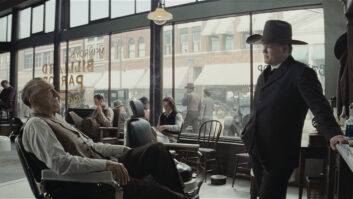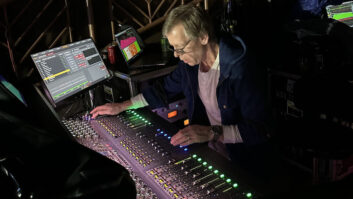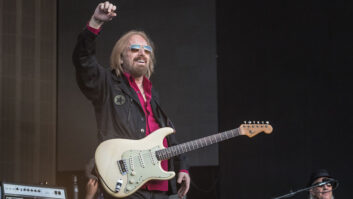
When film directors and actors revisit cherished characters and “franchises” many years, or even decades, after their initial successes, they do so at their own peril. The landscape is fairly riddled with long-delayed sequels and prequels that failed to measure up in the popular mind, from The Two Jakes (Chinatown II) to Godfather III to, yes, even the mega-successful recent Star Wars trilogy.
But the public has been clamoring for a fourth Indiana Jones adventure from Steven Spielberg and Harrison Ford basically ever since Indiana Jones and the Last Crusade was released in 1989. And now Indy is back — cue iconic John Williams main theme! By the time you read this story, Indiana Jones and the Kingdom of the Crystal Skull will have been in theaters for a week or more and both the critics and the public will have weighed in on whether the old Indy magic is still there. Sitting here writing about the film weeks before it opens, however, I can say this much: Everyone involved in the film seem to love working on it, and the post sound team, some of whom I interviewed right after the final mix was completed in late April, definitely believe that the film is up to very the high standards of the original 1980s Indy trilogy.

It helped that Spielberg was able to tap so many of the craftspeople who had either worked on the earlier films or who have been part of many or most of his more recent efforts. Editor Michael Kahn, composer John Williams and sound designer/supervising sound editor Ben Burtt all helped on Raiders of the Lost Ark way back in 1981 and were integral to Crystal Skull. Among the key post-production sound personnel, co-supervising sound editor Richard Hymns was a dialog editor on Indy II (The Temple of Doom) and a supervisor on III (The Last Crusade), as well as several other Spielberg films; ADR supervisor Gwen Whittle was a sound editor on III; and re-recording mixer Andy Nelson has handled music and dialog for a dozen Spielberg films since Schindler’s List. Additional sound designer and re-recording mixer Chris Scarabosio, fresh off an Oscar nomination for There Will Be Blood, has only been part of Spielberg’s retinue since Munich, but he has roots that go back to the Young Indiana Jones television series (for which he won an Emmy), and he was part of the Skywalker Sound group that made the three Star Wars prequels, which were, of course, directed by Indiana Jones co-creator/screenwriter/editor George Lucas. So the connections, and people’s affection for the material, run very deep.
Appropriately enough, the Crystal Skull post story begins with Burtt. “It started for me back in September [2007], when I went to L.A. and read the script in a secret room with a guard at the door,” he says with a chuckle during a break from mixing this summer’s Disney-Pixar spectacle, WALL-E. “They were still shooting at the time, and I hadn’t had a conversation with Steven yet. But I went through it, as I always would, making lists and noting questions and sort of deciding what are all the sounds I might need to make this movie? From the script, you can see there are going to be certain vehicles and certain weapons and locations, and you figure that for the Crystal Skulls themselves, you’ll need a lot of supernatural sounds like we did for the Ark or other things in the past. Then Richard [Hymns] and I were able to go down on four or five occasions and sit with Steven at the KEM flatbed in a traditional film editing room — as we would have done back on the earlier Indiana Jones films — go through the film and look at each scene and discuss what sounds were needed in greater detail, and get Steven’s ideas. Each time, I’d come back up here [to Skywalker Sound] armed with more specific marching orders as to what to do.”
Hymns comments, “Ben’s approach is really unique with Steven because they’re like a couple of kids — you put them together and everyone else becomes almost invisible. They talk in a language that most of us don’t understand, like Steven mentions an old movie and Ben immediately connects, knows exactly the sound he’s talking about — he might even have it in his library — and they move forward in that way. And they’re always talking about movies from the past to relate to the soundtrack we’re working on. To be in a spotting session with those two is a joy for me.”
In this case, Burtt says, “I knew from the beginning that we’d want to refer back again to some of the sounds we’d established in the earliest films because Indy still has a whip, he still has a gun, there are going to be fights and chases — though, of course, we wanted to do new things with those sounds, too. I always try to create a world of sound for each movie I work on. With this one, I knew we wanted to start by having the original library of sounds brought up to date because they really only existed on old quarter-inch tapes. Portions of them had been copied and digitized in a different manner over the years — some had gone to PCM and Betamax, or whatever we were using in the ’80s. But I didn’t trust those earlier generations, so I said, ‘Let’s go back and restore the whole collection.’” Burtt’s frequent sonic collaborator, Matt Wood, set up a work environment for Burtt’s 24-year-old son, Benny, to transfer the analog tapes to Pro Tools via a mint-condition Otari MX5050 and Apogee A/D converters. Everything was classified in a Sound Miner database so that the editors could easily get to any sound.
Even employing bits and pieces from the earlier films, Burtt, Scarabosio, Hymns and the sound editors still conjured up about 700 new sounds for Crystal Skull — which Burtt describes as fairly typical, while noting that for WALL-E, he and his team created the most sounds he ever has for a film — “about as many as all the Indy movies put together.” Because of conflicting schedules of the two films, Burtt had to “divide myself mentally very severely — certain days I would be just doing Indy and certain days I’d do WALL-E; I’d never try to mix the two.” Hymns organized and supervised much of the day-to-day work of the FX crew, and Scarabosio, in addition to doing additional sound design, later did most of the hands-on FX and Foley mixing, which was done down in L.A. at Fox (mainly to be closer to Spielberg) in a Neve DFC room laid out almost identically to the main mixing stage at Skywalker.
Burtt explains, “My job was to design the sounds for Indy, and for all the work they did up here at Skywalker, I was able to follow through and give the editors all the spotting sheets and lay out the structure for the whole film — kind of like an architect would lay out the plans — and then I was able to sit with each editor in each premix and get what I wanted out of it. Then it was sent to L.A. for final mixing, so at that point my main contact was I had the ability to sit in on the mix over the Skylink box so I could go into a room and see and hear in real time what they were doing, and also had a video iChat link so I could talk to the editors on the stage, or with the mixers, or with Steven, and that worked really well. Obviously, it’s not quite as good as being there in person, but sometimes I’d go down to the mix on weekends, so in the end it was fine.”

Chris Scarabosio, sound designer/re-recording mixer, was Oscar-nominated for There Will Be Blood.
Burtt generally likes to take a first stab at certain scenes himself and, as you might expect from the mastermind behind the sound of Star Wars and earlier Indy films, specializes in coming up with adventurous, unusual and supernatural FX — “sounds that don’t relate to the every day,” he says. “Sounds that are there for telling the story of things you encounter that you’ve never seen before,” such as the mysterious Crystal Skulls of the title (which all of the sound team refuse to describe for confidentiality reasons). Scarabosio notes, “Ben has such a talent for going over the top but not being completely crazy unless it’s appropriate because he has this other sense of being almost out of his mind. But when you put it to picture it works,” he says with a laugh.
Scarabosio and Hymns were responsible for more of the straightforward effects. Hymns explains: “I very specifically do the vehicles and anything vehicle-related, and other things in the more literal world. I don’t design sounds; I go out and record vehicles, and we did a lot of that on this one — all sorts of military vehicles and motorcycles, 99 percent of which I drove myself, and it involved a lot of crazy driving on an airfield and off-road.”
Much of that recording was done at remote Agua Dulce airport, located northeast of Los Angeles, “right near the Vasquez Rocks where a lot of old movies were filmed; a real historic spot. There’s a tiny airfield nearby you can rent. They close the whole thing down and it has half-a-mile or more of runway, and on the sides they have hills with dirt roads and there are huge stretches of somewhat flat and somewhat bumpy areas to do all sorts of things. So I had an array of vehicles that I drove like a lunatic. One of my sound effects editors, Addison Teague, and my assistant, Dee Selby, both had Sound Devices rigs — a 722 and two 744s — and a variety of mics. I like to mike the exhaust, the manifold, the engine compartment, the interior in stereo if it’s got an interior. We did some racing and jumping and landing, bumps and rattles galore. For some things, we used the library — obviously, we’re not going to wreck cars every time we have one onscreen. We have a huge library of over 100,000 sound effects.

Ben Burtt, sound designer/supervising sound editor, worked on Raiders of the Lost Ark.
“There’s a 20-minute chase in the film,” he continues. “It’s a whole reel. The first time I saw it, my stomach sank and I remember Ben turning to me, and saying, ‘Well, you’ve got your work cut out for you!’ There were 50-plus pages of notes. I wrote down very specifically what the vehicles do: ‘A reflection shot of a hot rod tracking alongside another vehicle for six seconds, accels into frame alongside, tracks for three seconds, then drops back a little and then steadies behind a bit, then accelerates, fast-by, and into the distance.’ And they all have exact timings. My specialty, if I have one, is that when I write out these notes, I can get into a vehicle and in my head count it out and pretty much re-enact something so it fits the picture almost exactly so I don’t have to do too many [sound] edits. Plus, we have a rig on the site so I can look at the picture on a small screen, and say, ‘That’s going to work pretty close; I can edit that to fit,’ and know that I’ve got it and not just go out and record a bunch of stuff and go back to the edit room later, and say, ‘Oh, I forgot to do this!’ There were endless pages of notes and endless recordings to do, so we were out there for a couple of weeks.”
Scarabosio did “a lot of big metallic crashes and also a lot of organic-type stuff — vegetation and trees cracking, trees falling, trees hitting; there’s a whole chase in the jungle, so it’s what happens to that vegetation that I worked on partly. I did a lot of recording in China Camp [in Marin County]; there’s quite a lot of trees back there, and lots of different kinds of brush and trees in varying degrees of decay.”
In general, he says, the approach was to be focused and economical when it came to sound design. “One of the things we were trying from the outset was to not cut a bunch of extra stuff — we knew we didn’t want to have layers and layers of stuff that we’d have to keep removing later in the mix. The main thing was always to focus on what we knew was going to be important, and for the most part it’s pretty obvious.”
As always, the final mix was an intricate dance between effects, dialog and music — at every step along the way, the sound team knew that eventually their work would be interwoven with another grand and prominent John Williams score.
“John’s score is fantastic,” Hymns says. “I knew that it was going to be big, and I knew from Steven’s spotting sessions roughly where there would be music, but other than that, John doesn’t give you temps or guides to work against; but composers almost never do. You have to cut [FX for] everything because you don’t really know where the music’s going to go and you don’t know what music is going to be dropped or changed. Steven will sometimes change a cue, or sometimes John will say, ‘You know, I wrote this for here, but I’m thinking I’d rather switch to something softer.’ And if you haven’t cut the sound effects to play alone, you’re going to be left high and dry.”
In the case of the big chase scene, Hymns says, “It was the most difficult reel to mix because you’ve got nothing but effects running all the time and they’re very exciting and very necessary, and then you’ve got music that’s playing all the time and it’s very exciting and necessary, so it’s like a wall of sound, and you have to go through it inch by inch again and again and again, and you find these places where it’s best for the music to kind of duck down a little and the sound effects soar, and vice-versa. You weave this thing and it’s really something you cannot see when you begin; it’s very stressful trying to figure out how this is going to work. You don’t want to lose anything but you can’t play everything. It took several days getting that sorted out, and then it suddenly emerges. Different people have different ideas. It’s a real collaboration, and serendipity plays a part, too.”
“Actually, a lot of mixing is about removing things,” adds music and dialog mixer Andy Nelson during a break from working on Kung Fu Panda. “You’re always going to go into the game fully loaded, and then you start saying, ‘All right, what don’t we need?’ And we’re all involved in that process — the other mixers and even John Williams, who’s terrifically collaborative. When we’re putting a reel together, John has great ideas — not just about music, but about the feel of a scene.
“One thing that was new for me was that Shawn Murphy [who recorded the score at Sony] gave me a separate 5.1 mix of reverbs and that really helped me, because in some of the action scenes it allowed me to dry up the sounds slightly, which helps with clarity when you’re putting a lot of sound effects to it, and then in the more lush areas, it allowed me to play the reverb full level with the orchestra. So John and I would sit and experiment with that.
“The music tends to sort of set the style of the movie on a certain level,” Nelson continues, “and when you’re dealing with such an iconic piece as the Raiders theme — for me, I bring up the music faders and there’s that theme and I’ve got a big smile on my face — I’m in heaven playing with this stuff.”
Blair Jackson is Mix’s senior editor.

WATCH:
We got more sound mixing details on the making of this classic movie’s sequel







